As a longtime hiker, I’ve really struggled with plantar fasciitis over the years.The traditional advice never seemed to work for me. My doctor recommended a few stretches and told me to stay off my feet for a few months. That’s easier said than done when you work on your feet all day.
I ended up finding an occupational therapist that specializes in sports therapy and she helped point me in the right direction. The good news is that I finally cured my plantar fasciitis, but it took a few months of following a strict stretching routine. I still follow a basic stretching routine and thankfully I’ve been hiking for years without having any signs of plantar fasciitis.
How do you hike with plantar fasciitis? You need to stretch the arch of your foot (aka plantar fascia), achilles tendon, and calves. Rest for a few weeks while taking antiinflammatory medicine and wear shoes with proper arch support.
Plantar fasciitis is a very common overuse injury. So you need to give your feet a break for a while. If you focus on rehabilitation and stretching you should be hiking in no time. In the rest of this post, I’ll explain how to rehab plantar fasciitis, choose shoes with proper arch support and teach you how to avoid overuse injuries on the trail.
Table Of Contents
How To Hike With Plantar Fasciitis
I tore my plantar fascia in the dumbest way possible. My feet were sore after a long hike and I decided to drive home barefoot. Once I got home I tried walking across the driveway without shoes and ended up tearing my plantar fascia stepping on a landscape timber. It was such a simple injury that led to months of serious pain.
It’s hard to say if I would have torn my plantar fascia just because of the long hike, but it’s one of those injuries that you don’t realize is a problem until it’s too late. You’ll have months of pain if you don’t catch it early.
I’m by no means a doctor, but I do know how to bounce back from a plantar fasciitis injury. If you follow this post, you should be able to start hiking again in no time. Here’s a brief rundown of everything you need to cure plantar fasciitis and start hiking again.
- Get off your feet for a little while to give your plantar fascia some rest.
- Walking on your heels temporarily relieves pain, but eventually leads to shin splints.
- Stretch out your plantar fascia, calves, hamstrings, and achilles tendons.
- Wear plantar fascia compression socks and shoes with lots of cushion.
- Once your plantar fascia’s healed you need to find shoes with minimal support to build the muscles in your feet.
- Limit your hiking mileage and reduce your pack weight.
- Use Trekking Poles To Take Stress Off Your Feet
The Plantar Fasciitis Arch Support Myth
Most primary care doctors will tell you to buy shoes with good arch support and lots of cushioning. That’s great for temporarily relieving pain, but it’s actually one of the main causes of the main causes of plantar fasciitis. A primary care doctor knows about general health, but ligament injuries require a specialist.
Any doctor that tells you to wear padded running shoes for plantar fasciitis doesn’t know what they’re talking about. Wearing heavily padded running shoes feel great, but they take the stress off your shock absorbing muscles. Those muscles and ligaments get weak which leads to plantar fascia injuries.
The only time you should wear heavily padded shoes is when you’re trying to recover from a plantar fascia injury. Wear them for the first few weeks to allow your feet to recover, but you eventually need to strengthen your feet to prevent further injury. I’ll go over shoes that help strengthen your feet later in this article.
How To Tell If You Have Plantar Fasciitis
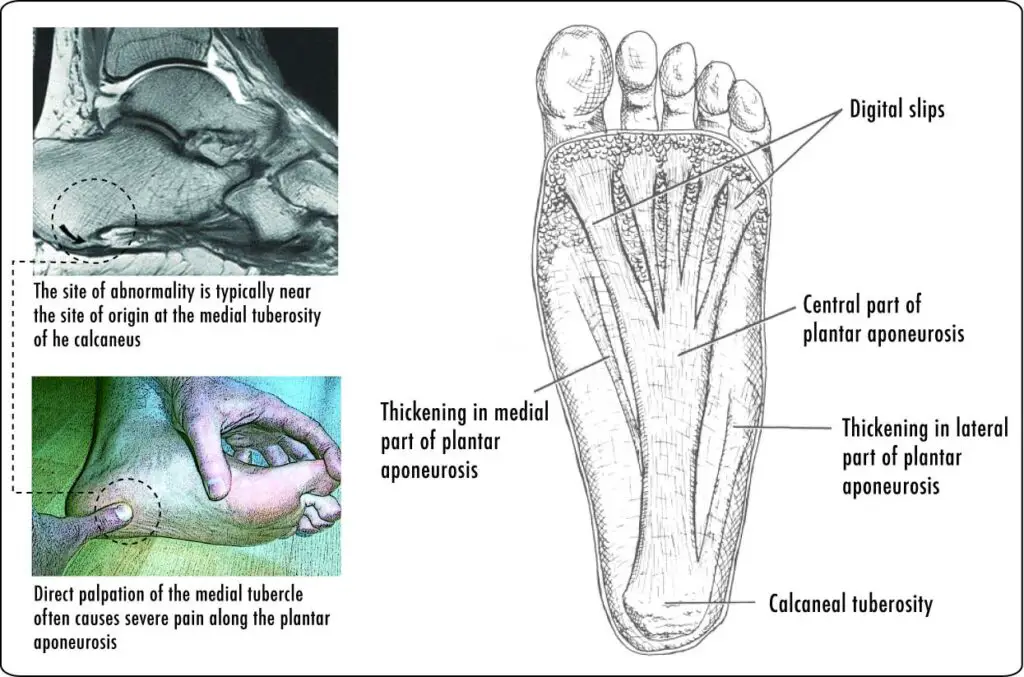
It’s fairly easy to tell if you have plantar fasciitis. Plantar fasciitis is a really intense pain on the heel of your foot as you walk. You should feel a sharp stabbing pain in the beginning of the day that eases up as you walk and stretch out your foot. These are the most common symptoms of plantar fasciitis.
- Stabbing pain around your heel and midfoot as you walk.
- Excruciating heel pain in the morning that slowly gets better as your muscles stretch throughout the day.
Plantar fasciitis is an overuse injury that can quickly get out of control if you ignore the symptoms. It feels like a sharp stabbing pain that happens every time your foot strikes the ground. When I first got plantar fasciitis it felt like I broke a bone in my heel.
The pain was subtle at first, but then it started happening every time I exercised and gradually worked its way into my normal day to day activities. It’s very common in people that have recently switched to long distance hiking, walking and running. Overweight people are more likely to experience problems, but it can happen to anybody.
So You Think You Have Plantar Fasciitis: Now What?
I won’t lie to you, Plantar Fasciitis really sucks! You’ve overworked the arch of your foot, so every step you take will be painful. The muscles in your feet are weak and you need to give them time to heal and work on stretching them out.
Your legs have a natural shock absorbing system to deal with stress of walking long distances. It’s mostly handled by your hamstrings, but the shock absorbing system goes all the way through your calves, achilles tendons and into the foots arch.
The plantar fascia is a ligament that connects the shock absorbing system to the bones in your feet. With overuse the plantar fascia tears and you won’t be able to put weight on your foot without further inflaming and agitating the ligament. Once you’ve torn the plantar fascia, you need to give it time to heal and work on strengthening the shock absorbing system.
You have to find a way to stretch out and strengthen the arch of your foot (aka Plantar Fascia), calves, Achilles tendons, and hamstrings. Your legs shock absorber goes from the arch of your foot, up through the achilles tendon, and into your calf/hamstring. Every piece of the puzzle needs to be rehabbed and stretched so this doesn’t happen again.
1. Give Your Feet Time To Rest: Plus Hot And Cold Treatments
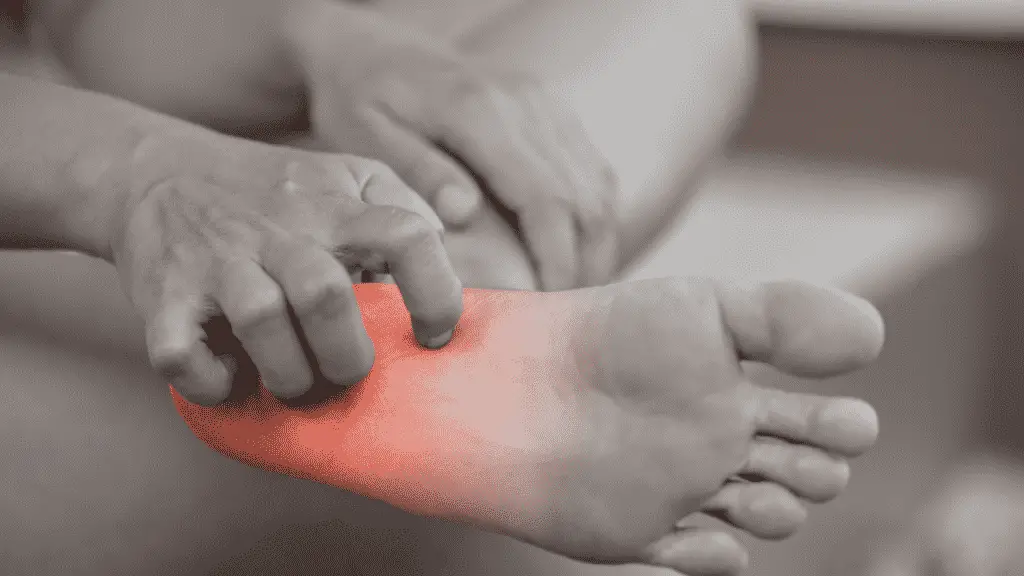
Rest is the only surefire way to cure plantar fasciitis. Unfortunately, that’s easier said than done! It’s hard to stay off your feet for 2-3 months, but you can limit the unnecessary strain on your plantar fascia.
Plantar fasciitis is an overuse injury caused by a torn ligament. Ligaments have a limited blood supply so ligament injuries are notoriously slow to heal. It won’t be like getting over a sprained/strained muscle. You need to stay off your feet for months and take a proactive approach to healing/strengthening the plantar fascia. Follow the RICE method for dealing with any type of overuse injury.
- Rest: Stay off your feet for 3-7 days to give your plantar fascia time to heal. It won’t be perfect, but it puts you at a place where it’s safe to stretch/strengthen the ligament.
- Ice: Cold therapy is essential for healing. Wrap your feet in ice for 15-20 minutes multiple times per day to reduce swelling. It reduces blood flow, which reduces inflammation and the risk of tissue damage. I also recommend taking anti-inflammatory pain medication.
- Compression: Plantar fasciitis compression socks offer support for your plantar fascia. It takes some of the work off your plantar fascia giving your ligament time to heal.
- Elevation: Elevate your feet above your heart to increase blood flow. Elevating your feet makes it easier for your heart to circulate blood since it’s not pumping against gravity. Gravities working in your favor and you’ll get more blood flow to the exterior extremities.
Resting is the hardest part for a lot of plantar fasciitis sufferers. The majority of cases of plantar fasciitis are in active people like runners, hikers, etc. You want to get back at it, but pounding away at sidwalks and trails will make the injury worse.
Try to stay off your feet for 3-7 days when you first notice the injury. That won’t be enough time to fully heal your ligaments, but it will put you on a path to recovery. It will take months of stretching and strengthening your feet to get back to normal.
Hot Versus Cold Therapy For Plantar Fasciitis
Heat/Cold compresses use 2 completely different methods to reduce pain. Heat increases blood flow which reduces pain but the increased blood flow causes swelling. Cold compresses decreases blood flow to reduce swelling and reduces the risk of further damage through swelling.
It’s a balancing act between increasing blood flow through heat and reducing blood flow with cold to reduce swelling that can lead to further aggravation.
Heat brings nutrients and oxygen rich blood to the affected area promoting healing, but it can cause long term issues if that leads to swelling. Cold compresses slow down healing by reducing the blood supply, but the reduction in inflammation protects the ligament from further damage.
My sports therapist would use heat before stretching/exercise to reduce pain and apply ice after to reduce swelling. The heat allowed me to get through the workout program without pain and the ice reduced swelling before it caused further damage. So use heat before exercise to reduce pain and ice after exercise to eliminate swelling.
2. Walking On Your Heels Will Temporarily Reduce Pain, But It Can Lead To Shin Splints
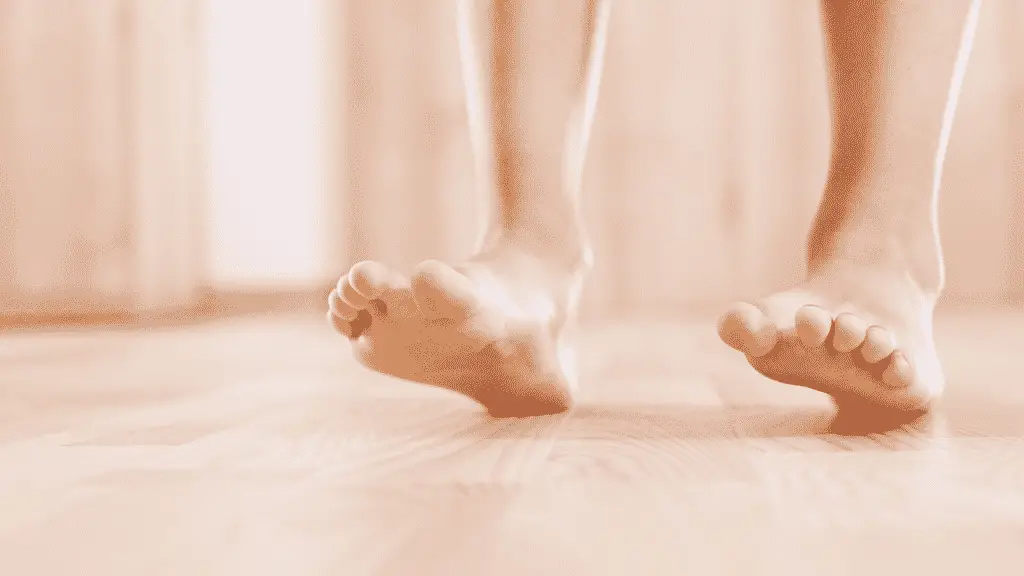
It doesn’t take long to learn that walking on your heels will temporarily reduce pain. This makes sense since you’re bypassing the shock absorbing system in your feet. Heel strikes send the force through your bones instead of up through the ligaments into your achilles tendon, calves and hamstrings.
That’s a great way to reduce pain, but you can only walk on your heels for short periods of time. Your transferring the impact force into your shins which aren’t designed to handle repeated stress. It works for the first week or two while you’re trying to rest, but don’t rely on walking on your heels for long.
Walking on your heels will eventually lead to shin splints caused by microfractures in your shins. You’re trading a temporary reduction in foot pain for a second injury that takes just as long to heal. There’s limited blood flow in your legs so shin splints will take just as long to heal as plantar fasciitis.
Plan on months of pain from the shin splints, plus your plantar fascia pain since you didn’t give your feet time to heal. Reducing the time on your feet, wearing plantar fascia compression socks, and increasing the cushioning in your shoes is a safer approach.
3. Stretch Out Your Plantar Fascia and Surrounding Muscles
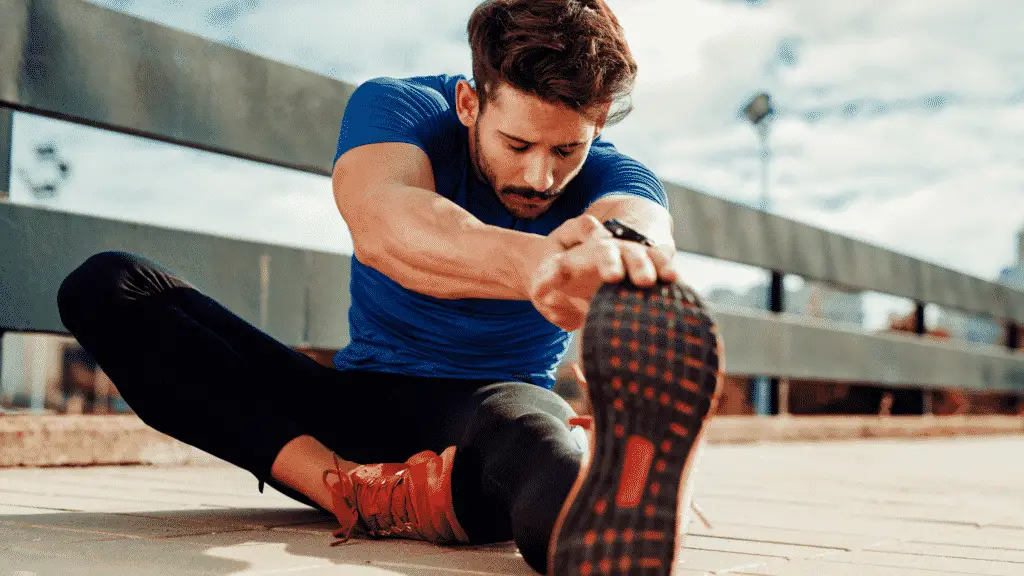
Overuse injuries are almost always caused by tight/weak muscles and ligaments. Your body can handle strength and flexibility issues during normal day to day activities, but the imbalance leads to injuries when you increase hiking and walking milage.
The bodies shock absorbing system will always fail at the weakest point. Your muscles and bones are strong, but the ligaments are weak. The plantar fascia is a very small ligament in the arch of your feet so that’s usually the first link in the shock absorbing chain to break.
Stretching out your plantar fascia is only part of the battle. If you have flexibility issues in any other part of your foots shock absorbing system it leads to an imbalance causing excess stress on your ligaments. So you need to stretch and strengthen every part of your shock absorbing system to reduce the risk of further injury. That means stretching out and strengthening your plantar fascia, calves, hamstrings, and Achilles tendons.
Stretching And Strengthening Your Plantar Fascia Will Take A While, But It’s Better Than Surgery
I went to a handful of doctors and occupational therapists that all told me the same thing. They all told me to work on stretching and strengthening my shock absorbing system. That sounds easy enough, but I’m a stubborn guy.
I was looking for immediate relief so I could get back to my active lifestyle. Going to the gym has always been fun, but I’ve always hated stretching and rehabbing injuries. That led to more than a year of pain before I finally stuck to my stretching/strengthening routine.
It can take 6-18 months to heal plantar fasciitis without medical treatment. If you don’t get on top of the problem early it can lead to chronic pain and serious injury. Ignoring the problem will eventually lead to serious injury that requires surgery.
Recovering from plantar fascia surgery means you’ll have to stay off your feet for months and still need to do the same stretching and strengthening routine. Do your stretches while you have a chance to recover without medical treatment. Don’t let plantar fasciitis become a chronic problem!
Use A Golf Ball To Stretch Your Plantar Fascia
Every doctor and occupational therapist tells you the same basic method to stretch your plantar fascia. There are specialized tools to stretch your plantar fascia, but all it takes is a golf ball. Any hard ball will help, but a golf balls smaller so it gives you a better stretch. I also use a plantar fascia foot rocker, but a golf ball is a cheap solution that you probably already own.
- Place a golf ball in your freezer to help reduce inflammation.
- Every morning you should wake up and roll your foot over the golf ball.
- You’re using the golf ball to break up knots in the muscle so it should hurt a bit. If you don’t feel a little bit of pain you’re not using enough pressure.
- Take 15 minutes every morning to stretch your plantar fascia and repeat the stretching whenever you have a few minutes throughout the day. I would do this when I sat down for dinner and while I was sitting at my desk at work and watching tv at night.
- You should notice an immediate improvement after 2-3 days of doing this. You still need to be careful since the ligaments still torn, but it should significantly reduce pain.
Plantar Fascia Foot Rockers, Slant Boards, and Nighttime Feet Stretchers
There are 100s of different products that claim to help with plantar fasciitis. They work by stretching the arch in your foot, calves and achilles tendons, and hamstrings. The golf ball method worked best for me, but they all help stretch the surrounding muscles in your foot/legs.
Plantar fascia foot rocker stretch in the opposite direction so it’s a great supplement to the golf ball. I didn’t notice an immediate improvement, but I was already using the golf ball so it’s hard to say how well it works. It did really help with my ankle flexibility which should reduce the risk of reinjury.
I also use a wooden slant board to stretch my calves, ankles, and achilles tendons. It doesn’t directly stretch your plantar fascia, but it will help with the surrounding shock absorbing muscles. Increasing flexibility in the surrounding muscles reduces the amount of strain on your plantar fascia.
The nighttime foot stretcher did absolutely nothing for me. It supposedly stretches your hamstrings, but I wasn’t able to keep it on for more than 5 minutes. Maybe it would have worked if I’d given it a chance, but regular hamstring stretches seemed to work better for me.
Stretching Your Ankles Calves And Achilles Tendons
As I mentioned above, I use a wooden slant board to stretch out my calves, ankles, and achilles tendons. I had terrible ankle flexibility so 2-3 months on a slant board made a huge improvement. You can stretch your ankles by leaning putting your feet up on the edge of your stairs, but the slant board made it easier to see improvement in ankle/calves flexibility.
You can check your ankle flexibility by placing your feet against 6 inches away from the wall and leaning forward with your knee. Your knees should be able to touch the wall without lifting your ankles. Work on your ankle flexibility if you can’t touch the wall with your knee. The following video will show you how to check ankle flexibility.
Put one foot on the slant board and lean forward for 15 seconds so you can feel a stretch in your calves. As you increase flexibility raise the angle on the board. You can do the same thing if you’re using the bottom stair to stretch, but you can’t increase/decrease the angle to adjust the stretch.
Stretch Your Hamstrings
Your hamstrings are another very important part of your shock absorbing system. It’s your hamstrings job to absorb the impact so your back, knee joints, pelvis and hips don’t absorb that force. If your hamstrings are tight it will cause your foot to strike the ground at an improper angle.
Doing some simple stretches every morning will help a lot. There are dozens of stretches you can do to improve hamstring flexibility so I can’t go over all of them, but the following video should help improve hamstring flexibility.
4. Wear Plantar Fascia Compression Socks and Cushioned Shoes Early In The Injury
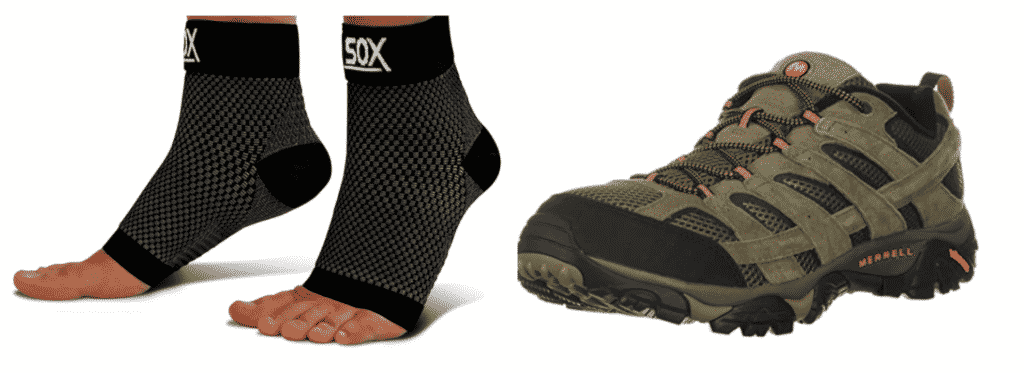
You need to take steps to reduce stress on your plantar fascia ligament early in the recovery process. After a few weeks you’ll need to work on strengthening and stretching your feet, but you need to focus on reducing further injury over the first few weeks.
Wear plantar fascia compression socks for the first month after the injury. Compression socks reduce swelling and help support the ligament while you’re walking. You should notice an immediate reduction in pain while wearing the compression socks.
Running shoes with lots of cushioning will also help reduce heel/arch pain. Cushioning reduces the stress on your bodies shock absorbing system, but it’s not a long term solution. You eventually need to transition into shoes with minimal support to stretch and strengthen your muscles/ligaments.
Understand that hiking and walking will be more comfortable, but you’re still injured! You need to limit the amount of time on your feet to reduce the risk of further injury. This is a temporary crutch to get your life back on track. Not a permanent solution! Give your feet time to heal and work on stretching and strengthening your plantar fascia and surrounding muscles.
5. Find Shoes With Minimal Support To Improve Plantar Fascia Strength
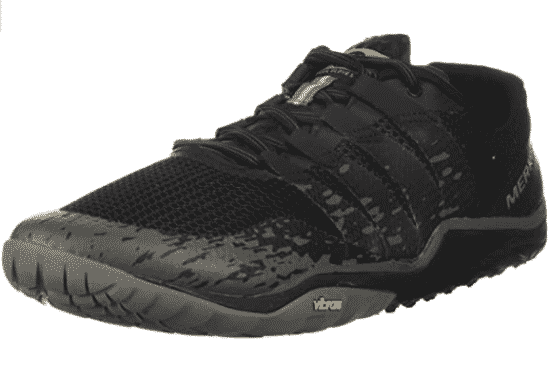
Cushioned running shoes reduces the impact force as you hike and walk/run taking stress off your muscles. That seams like a good thing, but it doesn’t allow your plantar fascia and surrounding muscles to build up strength. This will eventually lead to plantar fascia injuries since your muscles won’t be able to handle repeated abuse.
Wear cushioned shoes and compression socks while your rehabbing a plantar fascia injury, but you’ll eventually need to strengthen your feet. Find a pair of flexible neutral or negative heel shoes to increase feet strength. You’re looking for a minimalist style shoe that’s similar to barefoot walking.
Just be careful because you can just dive in from one extreme to another. Most people are used to cushioned running shoes so it will take a few months to adjust to the change. Practice walking in the shoes for an hour at a time until your feet get used to the change. It will take months to a year to heal damage from wearing bad shoes so it’s a slow transition.
I use a minimalist trail running shoe now that my plantar fasciitis is healed. Merrell’s Trail Glove are my favorite, but every hiking shoe manufacturer makes a minimalist trail running shoe. Hiking boots also have minimal cushioning, but those won’t be as comfortable on long hikes. Go down to the next section if your currently rehabbing a plantar fascia injury.
Best Hiking Boots For Plantar Fasciitis
If you’re currently dealing with plantar fasciitis you need to find shoes with a lot of cushion. That won’t improve your foot strength, but it will help take stress off your plantar fascia. Most hiking boots have a flat sole, with no cushion. So you’ll want to transition over to a trail running shoe that provides additional cushion.
Look for trail running shoes with a large heel that provides lots of cushioning for your plantar fascia. I also recommend wearing plantar fascia compression socks under merino wool socks (I like Smartwool) to help with swelling. The merino wool socks will also help with cushioning and reduce moisture buildup to prevent blisters.
I like Merrell Trail Running shoes since they’re reasonably priced, but Salomon, Saucony, Brooks, Nike, etc. all make trail running shoes. Any hiking shoe with a high arch and thick sole will help reduce plantar fasciitis pain.
6. Limit Hiking Mileage and Reduce Your Pack Load
It takes 6-18 months to fully heal a plantar fascia injury. Rest your feet for the first month or so, but you should be able to get back into normal activities after that. Don’t plan on taking a 10+ mile hike in your first 6 months. Take things slow by building up your mileage over time so you can avoid further injury.
Limit your hikes to 1-2 miles for the first few months while you’re rehabbing the injury. Start off with 30 minute hikes 2-3 times per week and slowly work up your mileage. I wouldn’t even carry a pack for the first 6 months.
Ice your feet after every hike and don’t be afraid to take a break if you start to feel the pain coming back. Overdoing it once can set you back for months and lead to serious injury. You don’t want to injure yourself to the point where it requires surgery.
7. Use Trekking Poles To Take Weight Off Your Feet
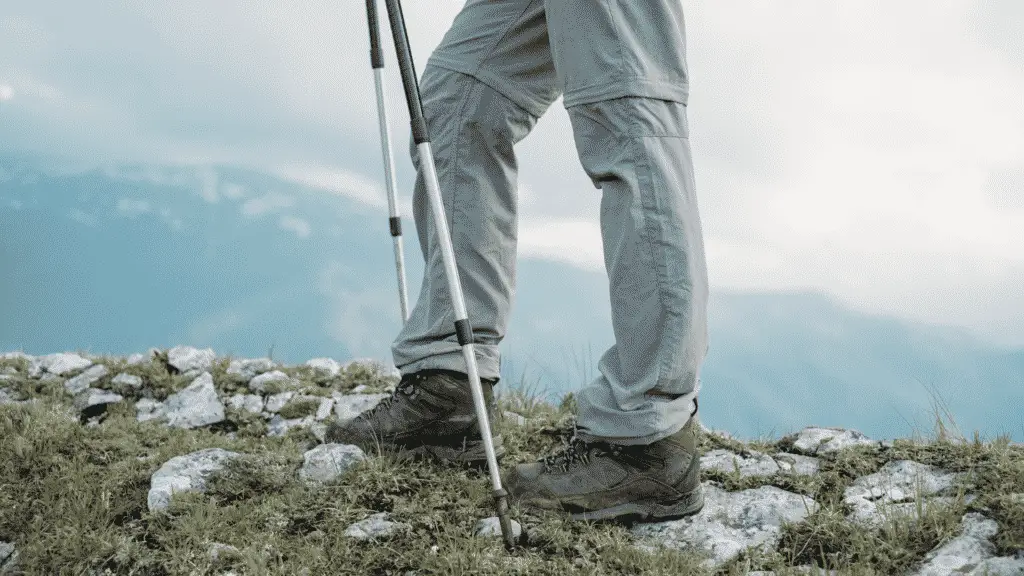
Trekking poles will help reduce the stress on your joints as you’re hiking. Trekking poles help transfer some of the weight from your feet/legs to your shoulders reducing lower body fatigue. Studies have shown that trekking poles cakes 20% of the weight off each step you take.
I’m a 200lb guy so that’s like losing 40 pounds which is a huge difference. It’s like taking a 5 gallon jug of water (43 pounds) worth of weight off your feet as you hike. That can make a huge difference over the course of a long hike.
You can buy a quality set of Leki, Black Diamond, or Komperdell trekking poles, but even cheap trekking poles will help. A set of cheap Cascade Mountain trekking poles weighs 10.4 oz and they’ll hold up for years. The aluminum design isn’t as light as carbon fiber, but a 4oz difference can save you $50-$75.




